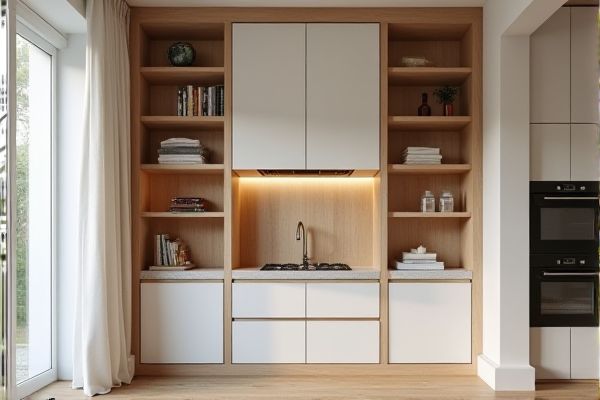
Stacked uppers maximize vertical storage space, offering more room for dishes and pantry items, while single row cabinets provide a streamlined, minimalist look that simplifies kitchen organization. Explore the advantages and design considerations to determine which option best suits Your kitchen needs in the full article.
Table of Comparison
| Feature | Stacked Uppers | Single Row Cabinet |
|---|---|---|
| Storage Capacity | Higher, utilizes vertical space effectively | Moderate, limited to single row height |
| Installation Height | Taller, may require step stool for access | Lower, easier reach for most users |
| Design Flexibility | Allows for layered aesthetics and added depth | Simpler, streamlined look |
| Cost | Typically higher due to increased materials and labor | Generally lower and more budget-friendly |
| Space Efficiency | Maximizes wall space; ideal for small kitchens | Requires more horizontal space |
| Accessibility | Upper shelves harder to reach for some users | All shelves easily accessible |
Introduction to Stacked Uppers and Single Row Cabinets
Stacked uppers offer increased storage capacity by layering multiple cabinet rows vertically, maximizing wall space efficiency in your kitchen or workspace. Single row cabinets provide a streamlined, minimalist design ideal for smaller areas, focusing on easy access and aesthetic simplicity. Comparing these options helps determine the best fit for your storage needs and spatial constraints.
Defining Stacked Upper Cabinets
Stacked upper cabinets consist of two cabinet boxes placed vertically, increasing storage capacity and height to fill wall space efficiently. These cabinets provide a bold, custom look by combining standard wall cabinets with a smaller cabinet on top, often reaching ceiling heights. Compared to single row cabinets, stacked uppers maximize vertical storage without extending cabinet depth or interfering with countertop space.
Understanding Single Row Cabinet Layouts
Single row cabinet layouts feature a single line of cabinets, optimizing space for narrow kitchens and enhancing accessibility within limited areas. This design simplifies organization and allows for straightforward appliance placement, maximizing efficiency in your kitchen workspace. Understanding these layouts helps you choose the best configuration for functionality and flow in compact environments.
Design Aesthetics: Stacked vs Single Row
Stacked uppers create a dynamic, layered visual effect, adding depth and sophistication to kitchen design, whereas single row cabinets offer a streamlined, minimalist look that emphasizes clean lines and simplicity. Stacked arrangements often allow for incorporating varied heights and open shelving, enhancing spatial interest and showcasing decorative elements. Single row cabinets deliver a classic, uniform appearance ideal for smaller spaces or minimalist aesthetics where uninterrupted wall space is preferred.
Space Optimization and Storage Capacity
Stacked uppers maximize vertical space by utilizing the full height of the kitchen walls, offering increased storage capacity compared to single row cabinets. Single row cabinets, while easier to access, provide less overall storage as they only occupy one layer of wall space. For kitchens with limited square footage, stacked uppers deliver optimal space optimization by doubling storage without expanding the kitchen footprint.
Installation Costs and Complexity
Stacked uppers typically demand higher installation costs and greater complexity due to the need for precise alignment, additional fastening hardware, and reinforcement of wall structures to accommodate the increased weight. Single row cabinets offer a simpler, more straightforward installation process with lower labor expenses and minimal structural modifications. Choosing between the two depends on budget constraints and the willingness to invest in more intensive installation work for increased storage capacity.
Accessibility and Ease of Use
Stacked uppers offer increased accessibility by providing more storage at eye level, allowing you to easily reach frequently used items without bending or stretching. Single row cabinets have a simpler layout which can make locating items quicker but may require more frequent organization to maintain ease of use. Your choice depends on whether you prioritize maximizing storage space or maintaining straightforward access to cabinet contents.
Kitchen Workflow and Functionality
Stacked uppers provide increased storage capacity and easy access to frequently used items, streamlining your kitchen workflow and enhancing functionality during meal prep. Single row cabinets offer a cleaner, more minimalist look while maintaining efficient organization for essential cookware and utensils. Choosing between these options depends on your kitchen size and cooking habits to optimize usability and space management.
Popular Trends in Cabinet Configurations
Stacked uppers have gained popularity in modern kitchen designs for maximizing vertical storage and enhancing visual interest compared to traditional single row cabinets. Designers favor stacked configurations to create customizable storage solutions that accommodate varying kitchen items, improving accessibility and organization. Single row cabinets remain a classic choice, particularly in compact spaces, where simplicity and streamlined aesthetics are prioritized.
Choosing the Right Cabinet Style for Your Kitchen
Stacked uppers maximize vertical storage by utilizing multiple shelves, ideal for kitchens needing extra organization without expanding footprint. Single row cabinets offer a streamlined look with easier accessibility, perfect for smaller kitchens or minimalist designs. Your choice depends on balancing storage needs with aesthetic preferences to enhance kitchen functionality and style.
 homyna.com
homyna.com